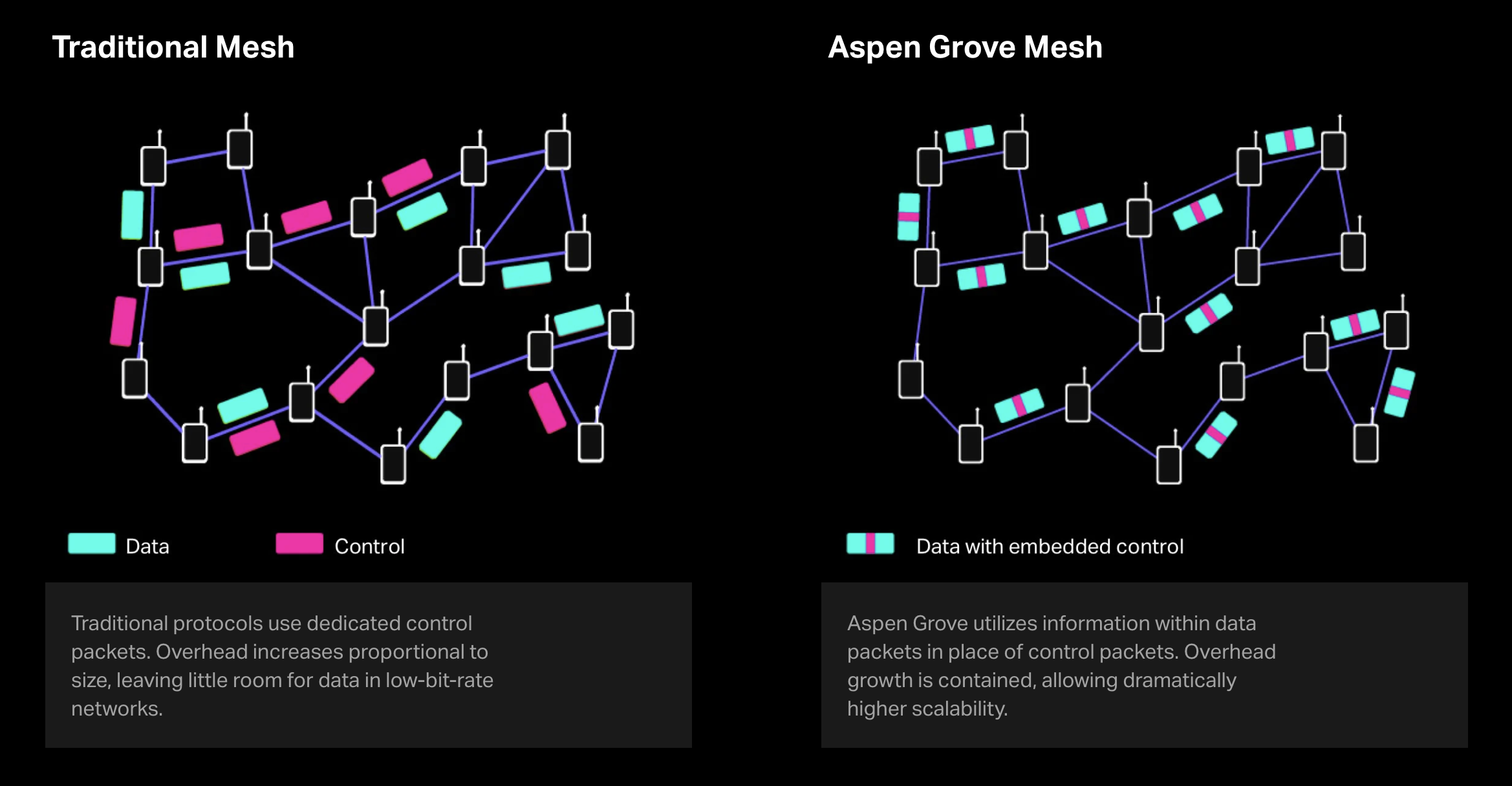Innovative Aspen Grove protocol has mobile mesh poised to go mainstream

There is a perception that mobile mesh networking is a new, novel technology that has only started to see adoption across the government, but that’s not entirely true. Mobile mesh networking is an established, relatively pervasive technology that can be found in radios carried by military and emergency personnel every day.
However, existing mobile mesh technologies and protocols integrated into the leading radios and communications equipment utilized by these organizations are not best suited to the current environment they face. This is especially true for the military – which is facing a unique situation where mobile mesh networking is becoming increasingly essential but also less effective.
Maj. Gen. Jeth Ray from the Network Functional Team at Army Futures when asked
“What does an ideal network look like?” at TechNet Augusta 2022:“Picture the edge. A soldier may have a radio in a mesh network, connected and able to receive sensitive but unclassified information.”
Courtesy of Government Executive
What is creating this mobile mesh “Catch 22?” It’s the evolving nature of warfare and the shifting threat landscape facing our nation and its allies. Let’s look at how today’s more sophisticated adversaries are making mobile mesh more necessary but also less effective. We will also take a look at how the Aspen Grove protocol can help bring mobile mesh into the mainstream.
Near peer adversaries and the degraded network
For the past two decades, the U.S. military has been focused on adversaries who had less sophisticated technology and resources than those held by the U.S. military. But that’s no longer the case.
Over the past few years, the U.S. military shifted focus from the Middle East to other regions such as the Indo-Pacific region. This theater or area of responsibility (AoR) is the location of two of the largest, near-peer adversaries of the US. Recent increases in hostilities, threatening behaviors, and adversarial messages between the U.S. nation and its adversaries in this region – China and Russia – led to the military shifting its focus to this region. That decision was later justified by Russia’s actions in Ukraine and the provocations that China has directed toward Taiwan.
This shift in strategic focus and the increased hostilities from these sophisticated, near-peer adversaries puts new pressure on our military. With a more sophisticated adversary comes additional capability to deny our military’s superiority across domains – and that includes the cyber domain.
Both Russia and China recognize the strategic edge communications networks deliver to the U.S. military. It makes sense that both adversaries would look to deny or degrade those communications networks and eliminate that strategic advantage in any military conflict.
The U.S., its allies, and coalition nations need to be prepared without a lack of central infrastructure when facing near-peer adversaries. Mesh networking is useful wherever there is little to no access to satellite or cell phone networks. These types of networks are needed to eliminate centralized points of failure and reliance on infrastructure. In cases where there are forces faced with bandwidth degradation or jamming, traditional mesh networking may not be enough.
Mobile mesh networking protocols traditionally utilized in military radios have a problem in these low-bandwidth environments – they don’t work at scale. In other words, for these mobile mesh protocols to effectively scale up in size and coverage area, they require a large amount of bandwidth.
The mobile mesh networking protocols that exist in today’s military radios and communications equipment are not smart enough to only retransmit signals when necessary. They also utilize large, dedicated control packets that are used to compute routes and direct traffic along those routes. These control packets increase in number as the network increases in size. So, for a large number of military users to leverage mesh networking with traditional protocols, they would need a high-bandwidth connection between the radios to accommodate all of the control packets.
This is where Aspen Grove comes into play.
Aspen Grove – a better, smarter approach to mobile mesh

Over the past year, multiple manufacturers of traditional military radios and communications equipment have reached out to goTenna to license the Aspen Grove mobile mesh protocol. This protocol – which we developed internally at goTenna – embeds the control information into the data packets. This approach eliminates the control packets altogether. Instead, Aspen Grove incorporates a small amount of control information in data packets to do the job that control packets did.
With no control packets tying up bandwidth, the mobile mesh network can grow to incorporate a large number of nodes across a large geographic area without the need for a massive amount of bandwidth.
The fact that established radio equipment providers could license goTenna technology is an exciting development. It illustrates that the military and its industry partners are concerned that the near-peer adversaries facing our country will deny our communications networks. It also shows that they’re embracing the innovation of small startup companies and seeking out new, technologically advanced approaches to established technologies to meet the challenges facing our modern military.
Traditional mobile mesh networking is widely integrated into the radios and communications equipment that the military is acquiring and issuing to U.S. warfighters. However, the traditional protocols being utilized in these devices can’t meet the needs or demands of bandwidth-restricted, degraded networks that our warfighters will invariably face against a new generation of near-peer adversaries.
By licensing and leveraging the Aspen Grove protocol developed by goTenna, these solution providers are ensuring that warfighters can continue to communicate and have basic situational awareness capabilities even when sophisticated adversaries deny, jam, or degrade networks.
By marrying new protocols with established technologies, mobile mesh networking is going mainstream – poised to be the reliable communications solution always available to the warfighter even when everything else is denied.
To learn more about how mobile mesh networking can provide an off-grid communications network for law enforcement personnel, click the links below:







No Comment